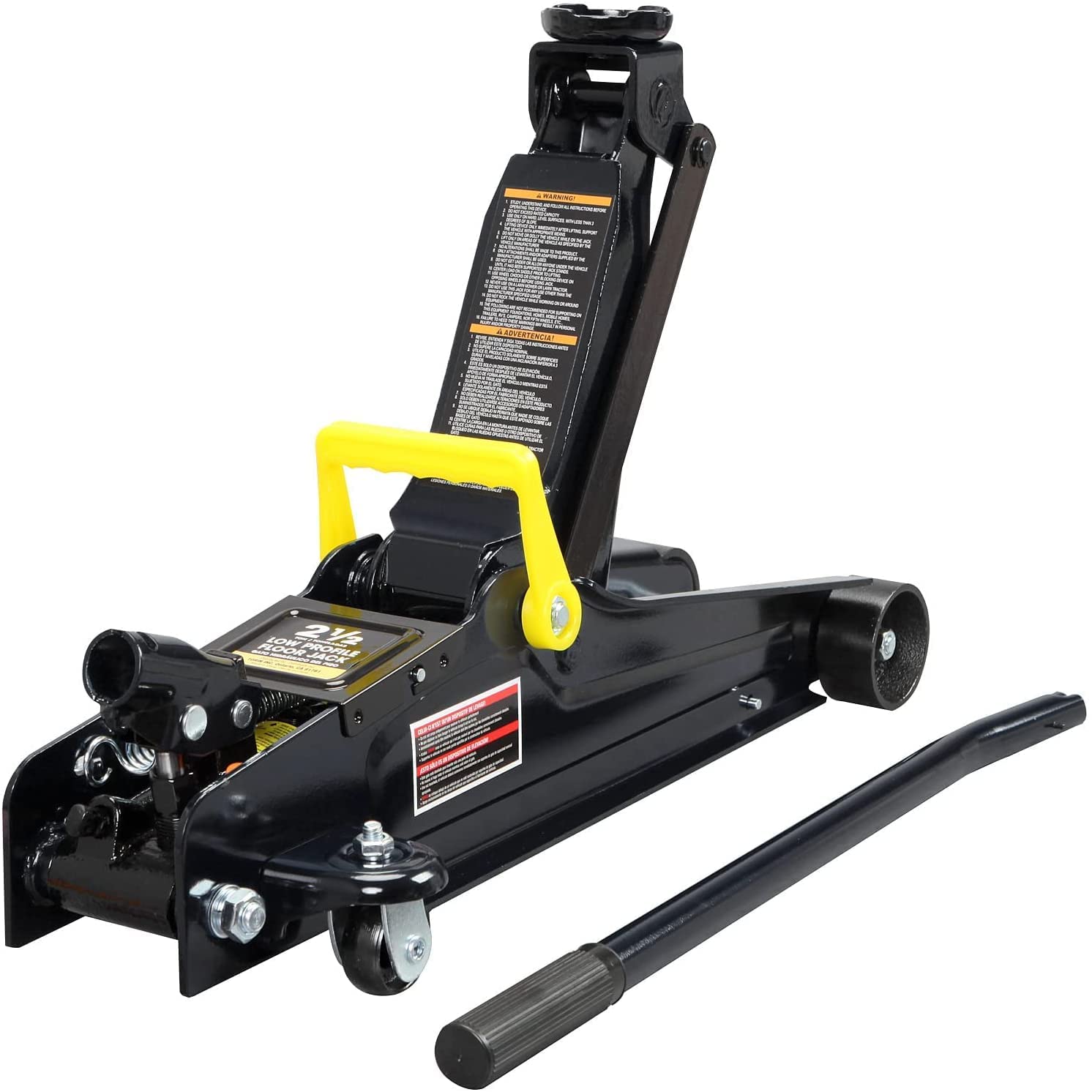To put hydraulic fluid in a floor jack, first, remove the cover plate and filler plug. Then, fill the chamber with hydraulic jack oil.
Afterward, follow the procedure to bleed excess air in the system, and your jack should be in good working order. If you’re looking for a step-by-step guide on how to add hydraulic fluid to a floor jack, there are various resources available online that provide detailed instructions and video tutorials.
Additionally, it’s important to remember that safety is paramount when working with a floor jack, so always use jack stands when lifting a car and follow proper procedures to ensure a safe working environment.
Understanding The Importance Of Hydraulic Fluid In A Floor Jack
Why Hydraulic Fluid Is Essential For The Proper Functioning Of A Floor Jack
A floor jack is a crucial tool for lifting heavy loads, such as cars or equipment, with ease. But have you ever wondered what makes it possible for a floor jack to lift such heavy weights effortlessly? The answer lies in the hydraulic fluid.
Hydraulic fluid is the lifeblood of a floor jack, enabling it to work efficiently and effectively. It plays a vital role in creating the necessary pressure to lift heavy objects, providing the force required to support the load. Without hydraulic fluid, a floor jack would be practically useless.
The Role Of Hydraulic Fluid In Providing Lift And Support
Hydraulic fluid works on the principle of Pascal’s law. When you apply force to the input mechanism of the floor jack, such as pumping the handle, the hydraulic fluid gets compressed. This compression creates pressure within the system, allowing the fluid to transfer the force to the hydraulic piston.
The hydraulic piston, connected to the lifting arm of the floor jack, reacts to this pressure and extends, providing the necessary lift to raise heavy objects off the ground. The hydraulic fluid acts as a medium for transmitting the force created at the input mechanism to the load being lifted, ensuring smooth and controlled lifting.
Risks Of Using A Floor Jack Without Sufficient Hydraulic Fluid
Using a floor jack without sufficient hydraulic fluid can be extremely dangerous and may result in serious accidents or damage to the equipment. Without enough hydraulic fluid, the pressure required to lift heavy loads is significantly reduced, compromising the jack’s lifting capacity.
When a floor jack is used without sufficient hydraulic fluid, the load may not be adequately supported. This can lead to sudden and unexpected collapses, posing a significant risk to both the user and the object being lifted. Additionally, the lack of hydraulic fluid can cause excessive strain on the hydraulic system, leading to premature wear and ultimately compromising the jack’s overall longevity.
Therefore, it is crucial to ensure that your floor jack is always filled with the correct amount of hydraulic fluid. Regularly checking and topping up the hydraulic fluid level will ensure that your floor jack operates smoothly and safely.
Preparing To Add Hydraulic Fluid To Your Floor Jack
Gather The Necessary Tools And Materials
To prepare for adding hydraulic fluid to your floor jack, gather the following tools and materials:
- Hydraulic jack oil (make sure it is the correct grade for your specific jack)
- Safety goggles
- Lubricating oil can or funnel
- Clean rags or paper towels
Ensuring A Safe Working Environment
Before starting the process of adding hydraulic fluid, it is crucial to ensure a safe working environment. Follow these steps to create a safe workspace:
- Make sure your floor jack is on a stable and level surface.
- Place wheel chocks or blocks behind the wheels of the vehicle you will be using the jack on.
- Wear safety goggles to protect your eyes from any potential splashes.
How To Identify The Location Of The Cover Plate And Filler Plug
To add hydraulic fluid to your floor jack, you need to locate the cover plate and filler plug. Here’s how to find them:
- Look for the cover plate on the side of the floor jack, usually near the base.
- Use a screwdriver or a designated tool to remove the screws or bolts holding the cover plate in place.
- Once the cover plate is removed, you’ll see the filler plug, which is where you will add the hydraulic fluid.
With these preparations complete, you are now ready to add hydraulic fluid to your floor jack and ensure its optimal performance. Remember to always consult your jack’s manual for specific instructions and guidelines.
Step-by-step Guide To Adding Hydraulic Fluid To Your Floor Jack
Step 1: Removing The Cover Plate And Filler Plug
Start by locating the cover plate and filler plug on your floor jack. The cover plate is usually located on the side or bottom of the jack, and the filler plug is usually located on the top of the jack. Use a suitable tool, such as a screwdriver or wrench, to remove both the cover plate and the filler plug. Set them aside in a safe place, as you will need them later.
Step 2: Selecting And Pouring The Appropriate Hydraulic Jack Oil
Now that you have access to the fill chamber, it is time to select the correct hydraulic jack oil. Refer to the manufacturer’s instructions or the user manual of your specific floor jack to determine the recommended type of hydraulic fluid. Once you have the correct oil, carefully pour it into the fill chamber. Use a funnel if necessary to avoid spills or splashes. Take your time and pour the oil slowly and steadily to ensure it reaches the fill chamber without overflowing.
Step 3: Avoiding Overfilling And Proper Filling Capacity
When adding hydraulic fluid to your floor jack, it is important to avoid overfilling. Overfilling can cause damage to the jack and lead to improper functionality. To ensure you do not overfill, refer to the manufacturer’s instructions or the user manual for the proper filling capacity of your specific floor jack. Once you have reached the recommended fill level, stop pouring the oil and wipe away any excess oil that may have spilled.
Step 4: Replacing The Cover Plate And Filler Plug Securely
After adding the hydraulic fluid, it is time to securely replace the cover plate and filler plug. Make sure the cover plate is positioned correctly and fits snugly over the opening. Attach it firmly using the appropriate tool. Then, take the filler plug and carefully screw it back into place on the top of the jack. Ensure it is tightened securely, but be careful not to overtighten it, as this can cause damage.
With these steps completed, you have successfully added hydraulic fluid to your floor jack. Remember to always follow the manufacturer’s instructions and refer to the user manual for any specific requirements or precautions for your particular model of floor jack.
Bleeding Excess Air From The Hydraulic System
Understanding The Importance Of Bleeding Air From The System
When it comes to maintaining the proper functioning of your floor jack, bleeding excess air from the hydraulic system plays a crucial role. Air bubbles trapped in the system can negatively affect the jack’s performance and potentially lead to safety hazards. Bleeding the air ensures that the hydraulic fluid can flow smoothly, allowing the jack to lift heavy loads efficiently and securely.
Procedure For Bleeding Excess Air In The Hydraulic System
- Start by locating the bleed valve on your floor jack. The valve is commonly found on the bottom of the jack’s reservoir.
- Position a suitable container underneath the bleed valve to catch any fluid that may be expelled during the bleeding process.
- Using a wrench, slowly loosen the bleed valve counterclockwise. As you do this, you may hear air escaping from the valve.
- Keep the valve open until the hissing sound stops and only fluid comes out. This indicates that the air has been successfully bled from the system.
- Tightly close the bleed valve by turning it clockwise with the wrench.
- Wipe away any spilled fluid and ensure that the area around the bleed valve is clean and free from debris.
Tips For Ensuring The Proper Functioning Of Your Floor Jack
- Regularly check the hydraulic fluid level in your floor jack and top it up as needed. Refer to the manufacturer’s instructions for the correct type and amount of hydraulic fluid to use.
- Inspect the jack for any signs of leaks or damage. If you notice any issues, immediately address them before using the jack.
- Always use jack stands in conjunction with your floor jack when lifting a vehicle. This provides an additional layer of safety and prevents accidents.
- If your floor jack is not functioning properly or feels unstable while lifting, refrain from using it and seek professional assistance or repairs.
- Store your floor jack in a clean, dry, and secure location to prevent dust, moisture, and other contaminants from affecting its performance.

Credit: www.roadandtrack.com
Frequently Asked Questions Of How To Put Hydraulic Fluid In A Floor Jack
How Do You Put Hydraulic Fluid In A Pallet Jack?
To put hydraulic fluid in a pallet jack, first, remove the cover plate and filler plug. Then, fill the chamber with hydraulic jack oil. Finally, follow the procedure to bleed excess air in the system. Always remember to use jack stands when lifting a car.
Can You Over Fill A Floor Jack?
No, you should not overfill a floor jack. Remove the cover plate and filler plug, then fill the chamber with hydraulic jack oil. Bleed excess air from the system and your jack will work properly. Always use jack stands when lifting a car.
How Do I Put Hydraulic Fluid In A Floor Jack?
To put hydraulic fluid in a floor jack, start by removing the cover plate and filler plug. Then, fill the chamber with hydraulic jack oil. Finally, follow the procedure to bleed excess air from the system. Your jack should now be in good working order.
Can You Overfill A Floor Jack With Hydraulic Fluid?
Yes, you can overfill a floor jack with hydraulic fluid. It’s important to fill the chamber to the recommended level specified by the manufacturer. Overfilling can lead to malfunctioning and potential damage to the floor jack.
Conclusion
To ensure the proper functioning of your floor jack, it is crucial to know how to put hydraulic fluid in it. Begin by removing the cover plate and filler plug, then fill the chamber with hydraulic jack oil. Make sure to follow the procedure to bleed excess air from the system.
Always remember to use jack stands when lifting a car for added safety. With these steps, your floor jack should be ready to tackle any lifting job efficiently. Don’t forget to check out the helpful videos on YouTube and consult reputable sources for further guidance on this subject.


Leave a Reply